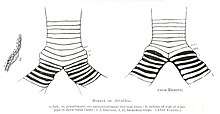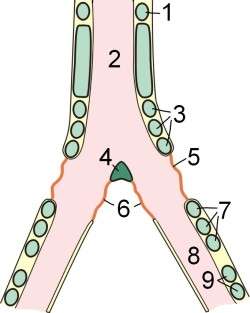Syrinx (bird anatomy)
The syrinx (Greek σύριγξ for pan pipes) is the vocal organ of birds. Located at the base of a bird's trachea, it produces sounds without the vocal folds of mammals.[1] The sound is produced by vibrations of some or all of the membrana tympaniformis (the walls of the syrinx) and the pessulus, caused by air flowing through the syrinx. This sets up a self-oscillating system that modulates the airflow creating the sound. The muscles modulate the sound shape by changing the tension of the membranes and the bronchial openings.[2] The syrinx enables some species of birds (such as parrots, crows, and mynas) to mimic human speech. Unlike the larynx in mammals, the syrinx is located where the trachea forks into the lungs. Thus, lateralization is possible, with muscles on the left and right branch modulating vibrations independently so that some songbirds can produce more than one sound at a time.[3] Some species of birds, such as New World vultures, lack a syrinx and communicate through throaty hisses.

Birds do have a larynx, but unlike in mammals, it does not vocalize.
The position of the syrinx, structure and musculature varies widely across bird groups. In some groups the syrinx covers the lower end of the trachea and the upper parts of the bronchi in which case the syrinx is said to be tracheobronchial, the most frequent form and the one found in all songbirds. The syrinx may be restricted to the bronchi as in some non-passerines, notably the owls, cuckoos and nightjars. The syrinx may also be restricted to the trachea and this is found in a very small number of bird groups that are sometimes known as tracheophonae, a subset of the suboscine passeriformes that include Furnariidae (ovenbirds), Dendrocolaptidae (woodcreepers), Formicariidae (ground antbirds), Thamnophilidae (typical antbirds), Rhinocryptidae (tapaculos), and Conopophagidae (gnateaters).[4] The trachea are covered in partly ossified rings known as tracheal rings. Tracheal rings tend to be complete, while the bronchial rings are C shaped and the unossified part has smooth muscles running along them. The trachea are usual circular or oval in cross section in most birds but are flattened in ibises. The trachea is simple and tubular in ducks. The last few tracheal rings and the first few bronchial rings may fuse to form what is called the tympanic box. At the base of the trachea and at the joint of the bronchi a median dorsoventral structure, the pessulus, may be developed to varying extents. The pessulus is bony in passerines and provides attachment to membranes, anteriorly to the semilunar membranes. The membrane that forms part of the first three bronchial rings is responsible for vibrating and producing the sound in most passerines. These membranes may also be attached to the pessulus. In some species like the hill-myna, Gracula religiosa, there is wide gap between the second and third bronchial semirings where large muscles are attached, allowing the inner diameter to be varied widely. Other muscles are also involved in syringeal control, these can be intrinsic or extrinsic depending on whether they are within the syrinx or attached externally. The extrinsic muscles include the sternotrachealis from the sternum.[5]
 The syrinx of hornbills
The syrinx of hornbills The cuckoo roller
The cuckoo roller The ostrich
The ostrich Suboscines and a shoebill
Suboscines and a shoebill
See also
- Bird call
- Talking bird
- Whistling
Notes
- Terres, J. K. (1980). The Audubon Society Encyclopedia of North American Birds. New York, NY: Knopf. p. 995. ISBN 0-394-46651-9.
- Larsen, O. N.; Franz Goller (2002). "Direct observation of syringeal muscle function in songbirds and a parrot". The Journal of Experimental Biology. 205 (Pt 1): 25–35. PMID 11818409.
- Suthers, R.A. (October 1990). "Contributions to birdsong from the left and right sides of the intact syrinx". Nature. 347 (6292): 473–477. Bibcode:1990Natur.347..473S. doi:10.1038/347473a0.
- Irestedt, Martin; Fjeldså, Jon; Johansson, Ulf S; Ericson, Per G.P (2002). "Systematic relationships and biogeography of the tracheophone suboscines (Aves: Passeriformes)" (PDF). Molecular Phylogenetics and Evolution. 23 (3): 499–512. doi:10.1016/S1055-7903(02)00034-9. PMID 12099801.
- Warner, Robert W. (1972). "The anatomy of the syrinx in passerine birds". Journal of Zoology. 168 (3): 381–393. doi:10.1111/j.1469-7998.1972.tb01353.x.
